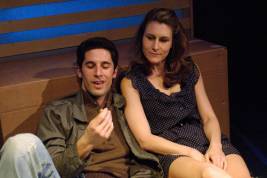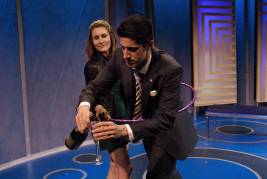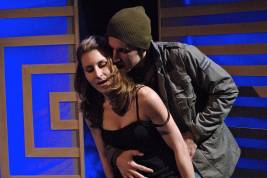RECOMMENDED
Austrian playwright Arthur Schnitzler’s 1900 play La Ronde so shocked the early 20th Century European theatrical world that it didn’t get its first public performance until 1920, and even then the play (and Schnitzler) were roundly attacked by critics and theatergoers alike. Hardly surprising, considering its plot—a sequence of not two or three, but ten sexual encounters. No matter that the most the play showed was a bit of foreplay, the actual sex taking place entirely in the audience’s imagination during brief blackouts. It was too much for Europe, let alone America, to take.
Fast forward a century or so and La Ronde has become one of the most adapted plays ever, from Max Ophüls’ and Roger Vadim’s foreign-language movies of the same name (and about a dozen more since then) to stage versions like Michael John LaChiusa’s musicalization Hello, Again and Joe DiPietro’s gay La Ronde, retitled F*cking Men, both of which have been rave reviewed on this site.
From Schnitzler to Hare, the premise is a simple one. A woman meets a man, they have sex, they part, the man goes on to meet and mate with another woman, who then does the same with yet another man, and so on, until the final man and the first woman have the play’s climactic (no pun intended) meeting. Hello Again and F*cking Men are written to be performed by a cast of ten actors. La Ronde has been staged both with a full cast and with only two actors playing all roles. David Hare’s modern adaptation The Blue Room was written with just two actors in mind.
The 1998 Broadway production of The Blue Room brought crowds out in droves to see Nicole Kidman’s very brief “backal” nudity, and it is this 21st Century La Ronde now being revived as a guest production at the Odyssey theater. (A note to gawkers. The nudity here is carefully staged and dimly lit to preserve the actors’ modesty.)
The current West L.A. production appears to have been mounted as a showcase for its two talented leads, Christian S. Anderson and Christina Dow, both of whom give it their all—though the results are somewhat mixed.
6’ 4” Anderson is a terrifically sexy leading man currently combining a successful career as a TV host with effective stage appearances like his recent turn in Stop Kiss. The lovely Dow too has numerous L.A. stage credits. Both are quite good in their multiple roles in The Blue Room, however Hare’s play, one which requires more chameleon-like actors, may not be the best vehicle for these romantic leads.
Any play asking an actor to undertake numerous distinct roles needs performers who can disappear into each part, so much so that you find yourself forgetting that it’s the same actor. Take for example Laura Linney and Julia Roberts. Both are fine Oscar-winning actresses, but Roberts would probably still be a version of Julia Roberts in all five Blue Room roles, while Linney would be almost unrecognizable from scene to scene. Both Anderson and Dow are more Julia Roberts than Laura Linney.
Under Elina de Santos’ direction, Anderson works hard to give us five different characters—the rough cabbie, the awkward student, sophisticated politician, etc., but you keep seeing the handsome leading man each time. He’s very good in all the roles, but not quite different enough. On a purely technical level, perhaps an occasional mustache or a different way of combing his hair might have helped. Some spot-on accents help Dow keep several of her characters distinct (the Southern prostitute, the French au pair, the British actress), and I liked much of what she did in her roles (the hula-hooping teenage model is adorable), but even more is needed to truly differentiate between them. A change of hairstyle for each character, perhaps? As a practical suggestion, both actors could benefit from listening to a few recorded novels on CD to hear how the best books-on-tape narrators create recognizably distinct voices for each character. Dow’s third character, the married woman, in particular could have been benefited from different vocal patterns from the actress’s own. Perhaps this could have been a greater focus of di Santos’ direction, which in other ways is as commendable as her actors’ efforts. Hare’s script is written in British English, which adds to the challenge. Playing most of the characters as American makes certain lines sound stilted. Perhaps this is why the Southern, British, and French-accented characters (thumbs up to JB Blanc’s dialect coaching) come across best.
The production is certainly not one for prudes. The fully committed Anderson and Dow go at it hot and heavy in each scene, though as in the Schnitzler original, the actual sex is never shown. (A clever conceit of Hare’s adaptation is that the length of each sexual encounter is projected above the stage during each blackout.)
Adam Flemming’s imaginatively abstract set design and a terrific choice of projections combined with Leigh Allen’s as always superb lighting make this a gorgeous production to watch. Christopher Moscatiello’s sound design and Arthur Loves Plastic’s original music punctuate scenes and blackouts for maximum dramatic effect. Dennis Ballard has chosen a nice variety of costumes for the ten characters, but since Anderson spends so much time wearing only underwear (no complaints about that), a change of (character-appropriate) undies might have made sense. Hope Glomski is production stage manager.
Ultimately, having recently seen F*cking Men, Joe DiPietro’s gay version of La Ronde, I was struck by how much richer DiPietro’s script is than Hare’s, how much more he gives his actors to work with, and how much deeper he allows the audience to identify with and become involved with the characters. Hare’s brittle writing keeps us always observing, not caring as much as we ought to.
In the final analysis, both Anderson and Dow have many fine moments in The Blue Room, and the production is worth seeing for numerous reasons, but perhaps this is a play best left up to the chameleons.
Odyssey Theatre, 2055 Sepulveda Blvd., Los Angeles.
www.plays411.net/blueroom
–Steven Stanley
April 11, 2010
Photos: Christopher Moscatiello





 Since 2007, Steven Stanley's StageSceneLA.com has spotlighted the best in Southern California theater via reviews, interviews, and its annual StageSceneLA Scenies.
Since 2007, Steven Stanley's StageSceneLA.com has spotlighted the best in Southern California theater via reviews, interviews, and its annual StageSceneLA Scenies.







 COPYRIGHT 2024 STEVEN STANLEY :: DESIGN BY
COPYRIGHT 2024 STEVEN STANLEY :: DESIGN BY